Letchworth was the first ‘Garden City’, inspired by the work of the urban planner Ebenezer Howard. He illustrated his idea for ‘Garden Cities’ with his famous three-magnets diagram, from which this Wetherspoon pub gets its name.
A photograph and text about The Three Magnets.
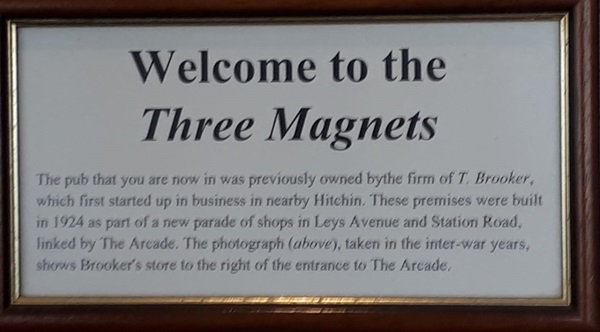
The text reads: The pub that you are now in was previously owned by the firm of T Brooker, which first started up in business in nearby Hitchin. These premises were built in 1924 as part of a new parade of shops in Leys Avenue and Station Road, linked by The Arcade. The photograph (above), taken in the inter-war years, shows Brooker’s store to the right of the entrance to The Arcade.
Illustrations and text about Reverend John Alington.
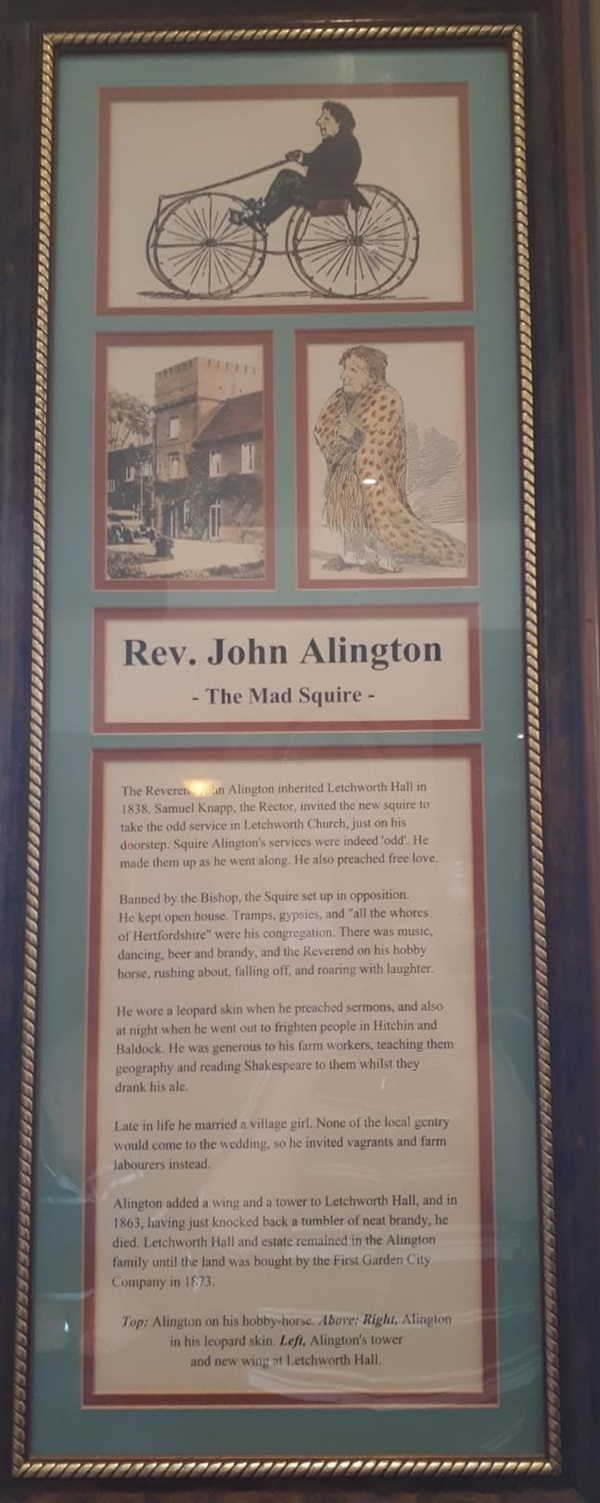
The text reads: The Reverend John Alington inherited Letchworth Hall in 1838. Samuel Knapp, the Rector, invited the new squire to take the odd service in Letchworth Church, just on his doorstep. Squire Alington’s services were indeed ‘odd’. He made them up as he went along. He also preached free love.
Banned by the Bishop, the squire set up in opposition. He kept open house. Tramps, gypsies, and “all the whores of Hertfordshire” were his congregation. There was music, dancing, beer and brandy, and the Reverend on his hobby horse, rushing about, falling off, and roaring with laughter.
He wore a leopard skin when he preached sermons, and also at night when he went out to frighten people in Hitchin and Baldock. He was generous to his farm workers, teaching them geography and reading Shakespeare to them whilst they drank his ale.
Later in life he married a village girl. None of the local gentry would come to the wedding, so he invited vagrants and farm labourers instead.
Alington added a wing and a tower to Letchworth Hall, and in 1863, having just knocked back a tumbler of near brandy, he died. Letchworth Hall and estate remained in the Alington family until the land was bought by the First Garden City Company in 1873.
Top: Alington on his hobby-horse
Above: right, Alington in his leopard skin, left, Alington’s tower and new wing at Letchworth Hall.
Prints and text about Castle Corset.
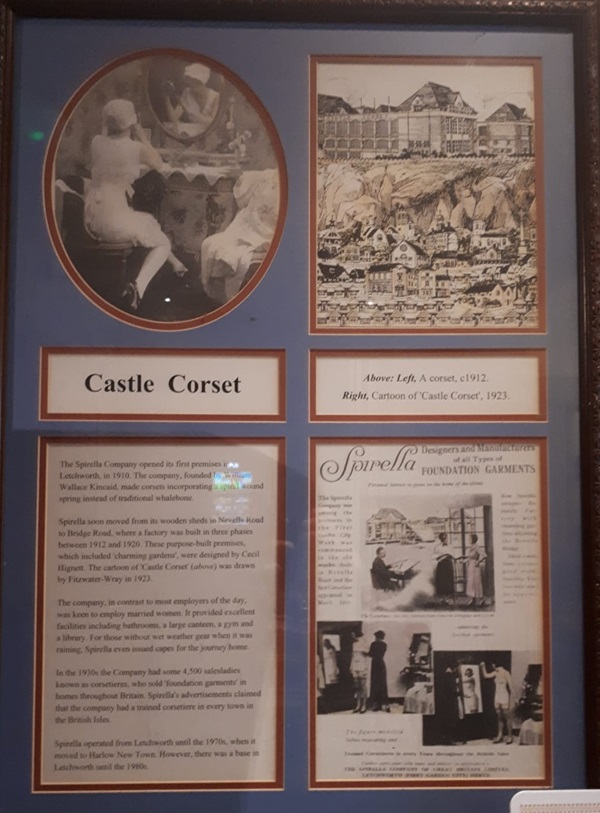
The text reads: The Spirella Company opened its first premises in Letchworth, in 1910. The company, founded by William Wallace Kincald, made corsets incorporating a spiral wound spring instead of traditional whalebone.
Spirella soon moved from its wooden sheds in Nevells Road to Bridge Road, where a factory was built in three phases between 1912 and 1920. These purpose-built premises, which included ‘charming gardens’, were designed by Cecil Hignett. The cartoon of ‘Castle Corset’ (above) was drawn by Fitzwater-Wray in 1923.
The company, in contrast to most employers of the day, was keen to employ married women. It provided excellent facilities including bathrooms, a large canteen, a gym and a library. For those without wet weather gear when it was raining, Spirella even issued capes for the journey home.
In the 1930s the company had some 4,500 salesladies known as corsetieres, who sold ‘foundation garments’ in homes throughout Britain. Spirella’s advertisements claimed that the company had a trained corsetiere in every town in the British Isles.
Spirella operated from Letchworth until the 1970s, when it moved to Harlow New Town. However, there was a base in Letchworth until the 1980s.
Text about George Bernard Shaw.
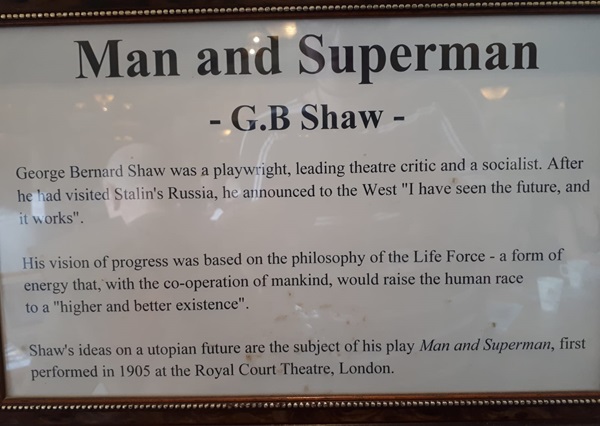
The text reads: George Bernard Shaw was a playwright, leading theatre critic and a socialist. After he had visited Stalin’s Russia, he announced to the West “I have seen the future, and it works”.
His vision of progress was based on the philosophy of the Life Force – a form of energy that, with the co-operation of mankind, would raise the human race to a “higher and better existence”.
Shaw’s ideas on a utopian future are the subject of his play Man and Superman, first performed in 1905 at the Royal Court Theatre, London.
Prints and text about local industry.
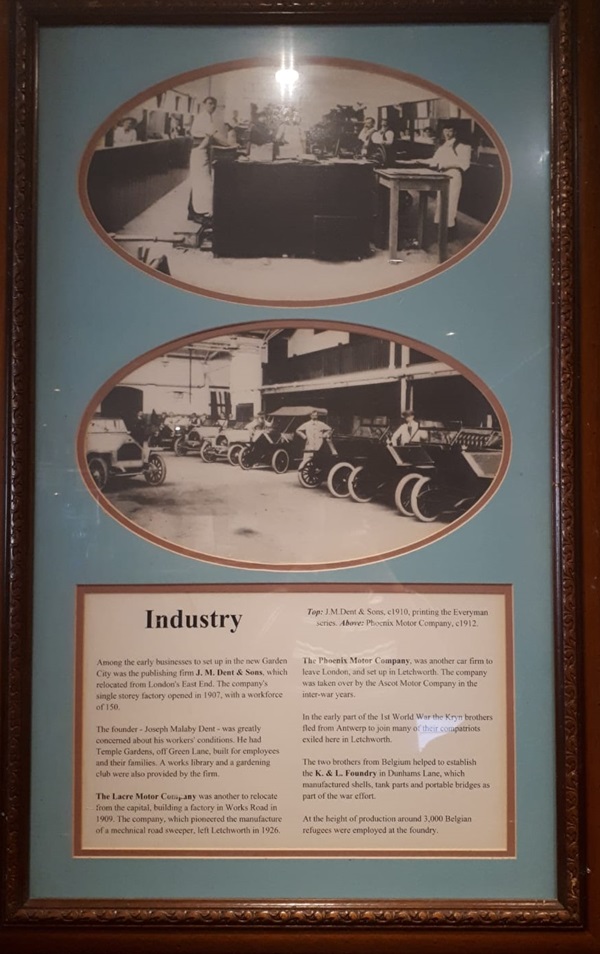
The text reads: Among the early businesses to set up in the new Garden City was the publishing firm JM Dent & Sons, which relocated from London’s East End. The company’s single storey factory opened in 1907, with a workforce of 150.
The founder – Joseph Malaby Dent – was greatly concerned about his workers’ conditions. He had Temple Gardens, off Green Lane, built for employees and their families. A works library and a gardening club were also provided by the firm.
The Lacre Motor Company was another to relocate from the capital, building a factory in Works Road in 1909. The company, which pioneered the manufacture of a mechanical road sweeper, left Letchworth in 1926.
The Phoenix Motor Company, was another car firm to leave London, and set up in Letchworth. The company was taken over by the Ascot Motor Company in the inter-war years.
In the early part of the 1st World War the Kryn brothers fled from Antwerp to join many of their compatriots exiled here in Letchworth.
The two brothers from Belgium helped to establish the K. & L. Foundry in Dunhams Lane, which manufactured shells, tank parts and portable bridges as part of the war effort.
At the height of production around 3,000 Belgian refugees were employed at the foundry.
Text about Ebenezer Howard’s plans for garden cities.
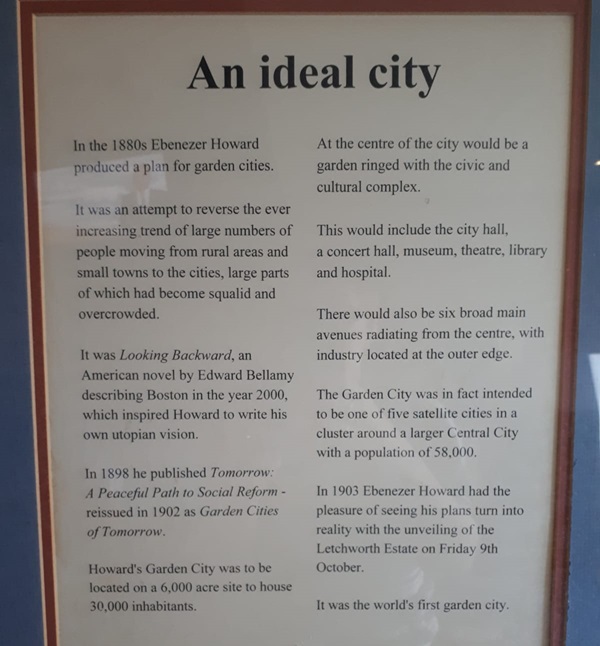
The text reads: In the 1880s Ebenezer Howard produced a plan for garden cities.
It was an attempt to reverse the ever increasing trend of large numbers of people moving from rural areas and small towns to the cities, large parts of which had become squalid and overcrowded.
It was Looking Backward, an American novel by Edward Bellamy describing Boston in the year 2000, which inspired Howard to write his own utopian vision.
In 1898 he published Tomorrow: A Peaceful Path to Social Reform – reissued in 1902 as Garden Cities of Tomorrow.
Howard’s Garden City was to be located on a 6,000 acre site to house 30,000 inhabitants.
At the centre of the city would be a garden ringed with the civic and cultural complex.
This would include the city hall, a concert hall, museum, theatre, library and hospital.
There would also be six broad main avenues radiating from the centre, with industry located at the outer edge.
The Garden City was in fact intended to be one of five satellite cities in a cluster around a larger Central City with a population of 58,000.
In 1903 Ebenezer Howard had the pleasure of seeing his plans turn into reality with the unveiling of the Letchworth Estate on Friday 9th October.
It was the world’s first garden city.
Photographs and text about Letchworth’s reputation as a place for the Simple Life.
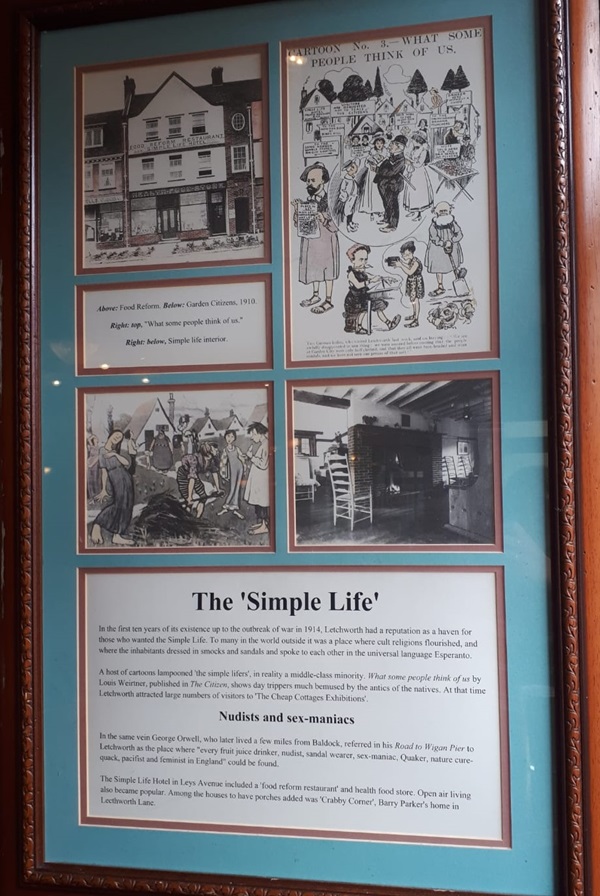
The text reads: In the first ten years of its existence up to the outbreak of war in 1914, Letchworth had a reputation as a haven for those who wanted the Simple Life. To many in the world outside it was a place where cult religions flourished, and where the inhabitants dressed in smocks and sandals and spoke to each other in the universal language Esperanto.
A host of cartoons lampooned ‘the simple lifers’, in reality a middle-class minority. What Some People Think Of Us by Louis Weirtner, published in The Citizen, shows day trippers much bemused by the antics of the natives. At that time Letchworth attracted large numbers of visitors to ‘The Cheap Cottages Exhibitions’.
In the same vein George Orwell, who later lived a few miles from Baldock, referred in his Road to Wigan Pier to Letchworth as the place where “every fruit juice drinker, nudist, sandal wearer, sex-maniac, Quaker, nature cure-quack, pacifist and feminist in England” could be found.
The Simple Life Hotel in Leys Avenue included a ‘food reform restaurant’ and health food store. Open air living also became popular. Among the houses to have porches added was ‘Crabby Corner’, Barry Parker’s home in Letchworth Lane.
A photograph of the railway station, Letchworth, c1914.
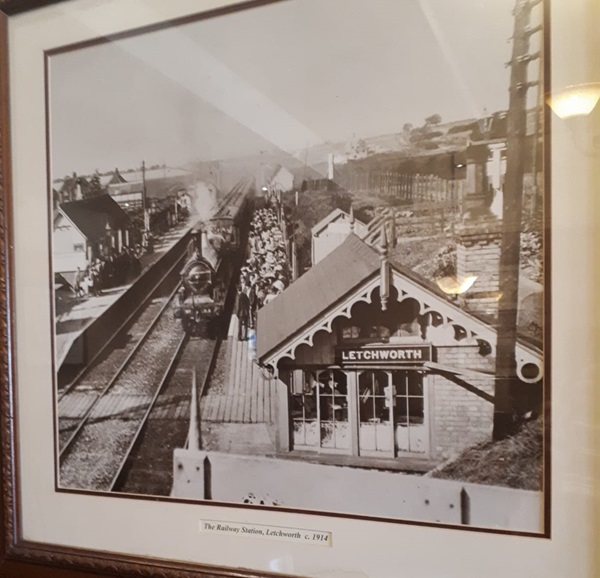
A print of haymaking at Letchworth, c1908.
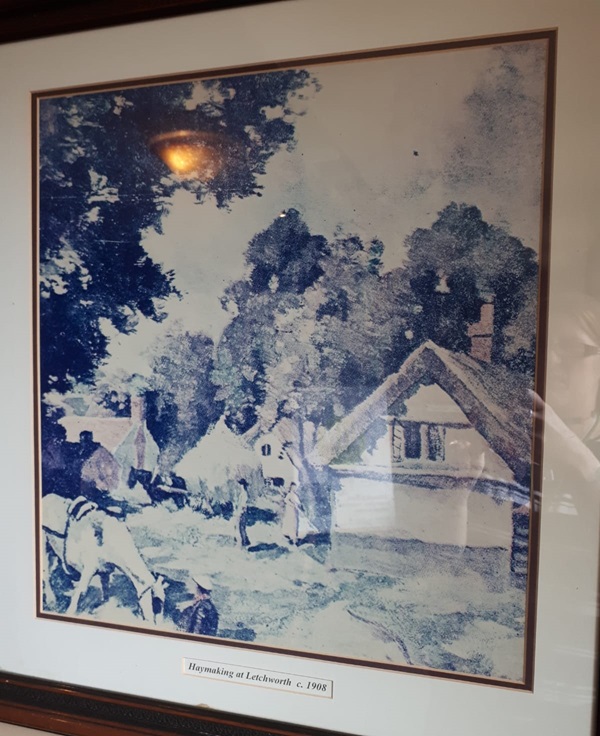
A photograph of the Broadway, Letchworth, c1912.
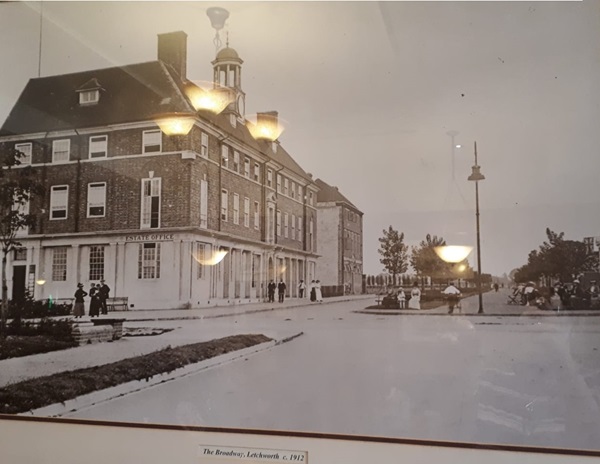
External photograph of the building – main entrance.
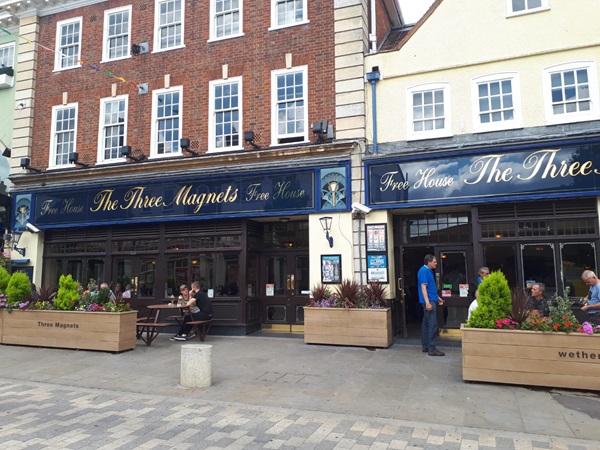
If you have information on the history of this pub, then we’d like you to share it with us. Please e-mail all information to: pubhistories@jdwetherspoon.co.uk